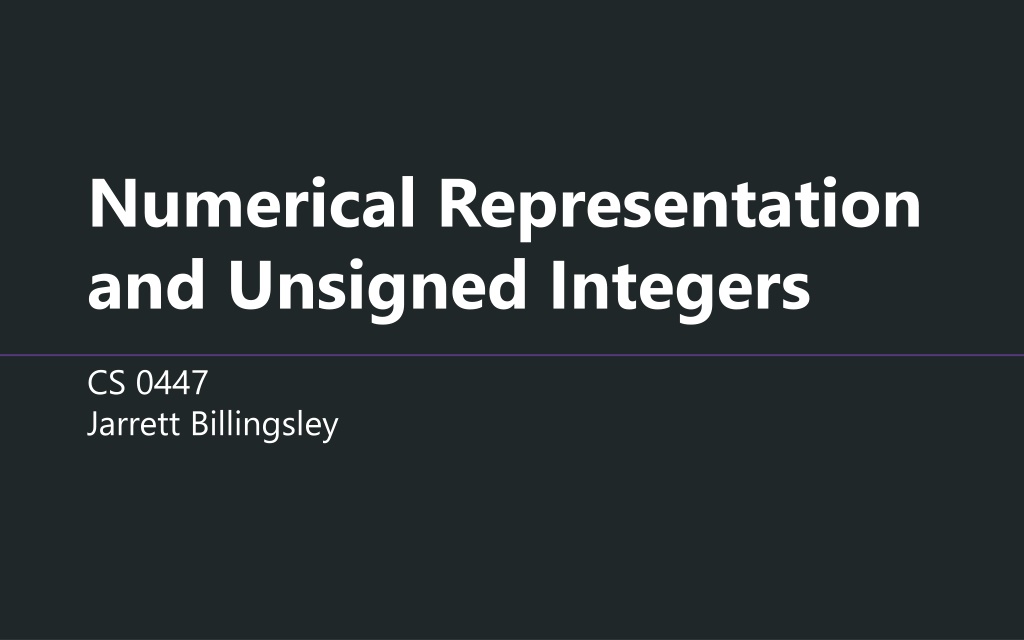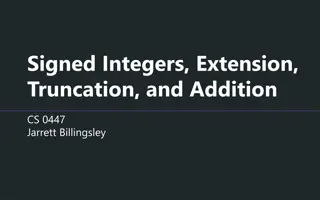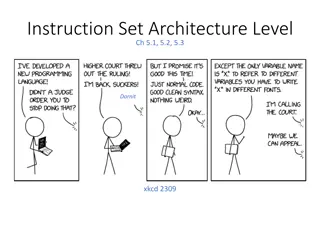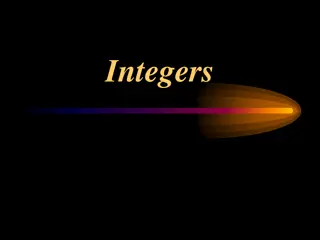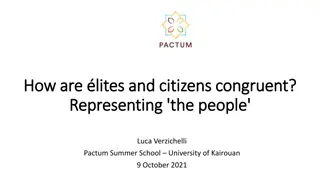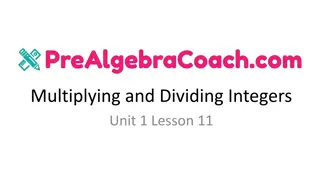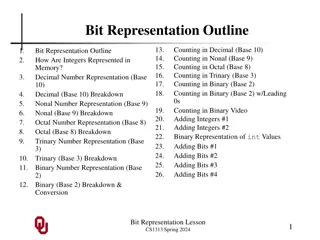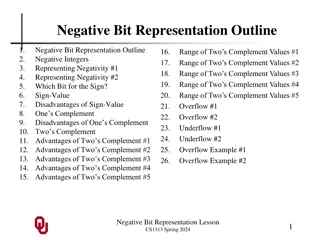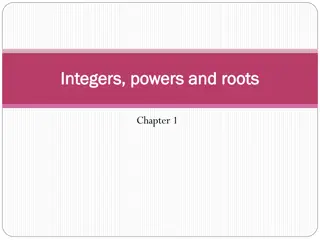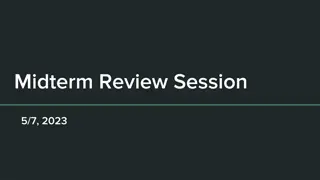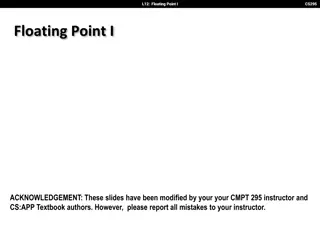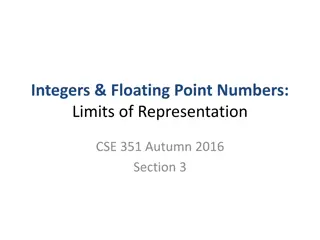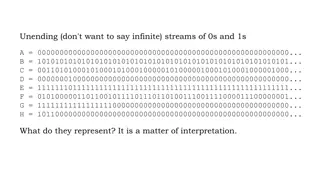Numerical Representation and Unsigned Integers
Fundamentals of binary number systems, unsigned integers, and positional number systems. Understand how numerical values are represented in computer science, the range of numbers they can express, and the rules for different numerical bases. Discover the significance of bits, binary digits, and learn about common numbering systems like decimal, binary, and hexadecimal. Enhance your understanding of numerical representation with engaging exercises and practical examples.
Download Presentation

Please find below an Image/Link to download the presentation.
The content on the website is provided AS IS for your information and personal use only. It may not be sold, licensed, or shared on other websites without obtaining consent from the author.If you encounter any issues during the download, it is possible that the publisher has removed the file from their server.
You are allowed to download the files provided on this website for personal or commercial use, subject to the condition that they are used lawfully. All files are the property of their respective owners.
The content on the website is provided AS IS for your information and personal use only. It may not be sold, licensed, or shared on other websites without obtaining consent from the author.
E N D
Presentation Transcript
Numerical Representation and Unsigned Integers CS 0447 Jarrett Billingsley
Class Announcements repeat after me: o 1 byte is 8 bits there are exercises that go with each lecture! o go to my page, Materials, then Exercises also lab1 is out, tells you how to install MARS o or re-install it, for those of you who have it from a previous term CS447 2
Binary CS447 3
Positional number systems the numbers we use are written positionally: the position of a digit within the number has a meaning 1,234 100s 1000s 102 103 = Most Significant Least Significant 1 103 + 2 102 + 3 101 + 4 100 10s 101 1s 100 how many digit symbols do we have in our number system? 10: 0, 1, 2, 3, 4, 5 ,6 ,7, 8, 9 CS447 4
Range of numbers suppose we have a 4-digit numeric display what is the smallest non-negative integer it can show? what is the biggest integer it can show? how many different values can it show? o 9999 - 0 + 1 = 10,000 what power of 10 is 10,000? o 104 let's generalize. with n digits: o how many values can we show? 10n o what is the largest integer we can show? 10n-1 CS447 5
Numeric Bases we use a base-10 (decimal) numbering system but we can use (almost) any number as a base! the most common bases when dealing with computers are base-2 (binary) and base-16 (hexadecimal) when dealing with multiple bases, you can write the base as a subscript to be explicit about it: 510 = 1012 CS447 6
Rules for Bases given base B, o there are B digit symbols o each place is worth Bi, starting with i = 0 on the right o given n digits: you can represent Bn different values the largest representable integer is Bn 1 so how about base-2? o how about with 5 binary digits? CS447 7
Binary (base-2) we call a binary digit a bit a single 1 or 0 when we say an n-bit number, we mean one with n binary digits 1001 0110 1 128 + 0 64 + 0 32 + 1 16 + 0 8 + 1 4 + 1 2 + 0 1 = 15010 = MSB LSB 27 26 25 24 23 22 21 20 128s 64s 32s 16s 8s 4s 2s 1s to convert binary to decimal: ignore 0s, add up place values wherever you see a 1. CS447 8
Making change you want to give someone $9.63 in change, using the fewest bills and coins possible. how do you count it out? 1 4 -$4= $4.63 $0.63 left:$9.63-$5= $5 $1 25 10 5 1 __ 2 1 0 3 $0.03 $0.00 $0.13 $0.03 -50 = -10 = -0 = -3 = biggest to smallest most significant to least significant WHERE COULD THIS BE GOING... CS447 9
Converting decimal to binary you want to convert the number 8310 to binary. 128s 64s 32s 16s 8s 4s 2s 1s left:83- 0 = 83 19- 0 = 19 3 3 3 1- 1 =0 - 64 = - 16 = - 0 = - 0 = - 2 = 01010 011 for each place from MSB: o if place value remainder: digit = 1 remainder = remainder - place o else, digit = 0. it's like long division! CS447 10
Bits, bytes, nybbles, and words 8 bits (8b) = 1 byte (1B) do not confuse nybbles with bytes! bit number: 7 6 5 4 3 2 1 0 1 bit 1 bit 1 bit 1 bit 1 bit 1 bit 1 bit 1 bit 4 bits (4b) = 1 nybble another nybble also, most things are measured and manipulated in multiples of bytes, not bits. a word is the "most comfortable size" of integer for a CPU. that means the size of numbers it can operate on. when we say 64-bit CPU," we mean its word size is 64 bits. CS447 11
The Big Thing everything on computers is encoded in binary. every variable you have ever declared, every number you have typed in and printed out, every string, object, file, image, sound, video, program, document o everything is a sequence of 0s and 1s. why binary? cause it's easy. o easy to make circuits, easy to do math, and easy to make it run fast. in computer science (and many other areas), it s often best to do the simplest thing that works, and build everything else on top of that. o we don t need base-10 computers, because base-2 computers are simpler, and conversion between base-2 and base-10 is easy. CS447 12
Hexadecimal CS447 13
Shortcomings of binary and decimal Binary numbers can get really long and really unreadable. o 3,927,66410 = 11 1011 1110 1110 0111 00002 But powers of 2, which look nice in binary, look arbitrary in decimal. o 10000000000000002 = 32,76810 What we want is an auxiliary base, one which makes powers of 2 look nice, but which is more compact than binary. o It s not just for aesthetics; it s about revealing patterns. To do this, we could pick any base which is itself a power of 2, like base-4, base-8, base-16, base-32, etc. o base-4 is not much terser than binary 3,927,66410 = 120 3331 2323 00004 o base-32 would require 32 digit symbols o but base-8 and base-16 look promising! (spoilers, no one uses base-8 (octal) anymore) CS447 14
Let's make a base-2 16 number system here are the rules again: o given base B, there are B digit symbols each place is worth Bi, starting with i = 0 on the right given n digits: you can represent Bn different values the largest representable integer is Bn 1 so how about base-16? o how about with 4 hex digits? CS447 15
Hexadecimal or "hex" (base-16) digit symbols A, B, C, D, E, F mean 10, 11, 12, 13, 14, 15 we call one hexadecimal digit a hex digit. or a nybble? 003B EE70 = 0 167 + 0 166 + 3 165 + 11 164 + 14 163 + 14 162 + 7 161 + 0 160 = 167 166 165 164 163 162 161 160 to convert hex to decimal: use a dang calculator lol 3,927,66410 (or, convert to binary, then to decimal) CS447 16
The magical relationship 4 bits (1 nybble)are equivalent to 1 hex digit 1 byte = 8 bits and therefore 2 hex digits (or 2 nybbles) how many hex digits is a 32-bit number? how many bits is a 5-digit hex number? 0xB8 = 1011 10002 = 18410 (this is common notation for hex, derived from the C language. it s NOT part of the number.) these are three ways of representing the same value. they're different views of the same data. CS447 17
Converting between binary and hex say we had this binary number: 11101111101110011100002 starting from the LSB (right side): o divide into groups of 4 bits (nybbles) (add 0s to the left if needed) o convert each nybble to 1 hex digit 0011 1011 1110 1110 0111 0000 3 B E E 7 0 0x hex binary? look at the table and go the opposite way! Bin Hex Bin Hex 0000 0 1000 8 0001 1 1001 9 0010 2 1010 A 0011 3 1011 B 0100 4 1100 C 0101 5 1101 D 0110 6 1110 E 0111 7 1111 F know this table. CS447 18
Powers of Two Dec 20 1 21 2 22 4 23 8 24 16 25 32 26 64 27 128 Hex Dec Hex 28-1 = 255 = 0xFF = max value of an unsigned byte 1ki (like kibibyte) 28 29 210 212 216 220 231 232 0x1 256 0x100 0x2 512 0x200 0x4 1,024 0x400 0x8 4,096 0x1000 0x10 65,536 0x10000 1Mi (like mebibyte) 231-1 = 2,147,483,647 = 0x7FFFFFFF = max value of a Java int 0x20 1,048,576 0x100000 0x40 0x80000000 2,147,483,648 0x80 4,294,967,296 0x100000000 memorize at least the powers up to 210 CS447 19
Unsigned Integers and the limits of computers CS447 20
Number line segment let s look at the integers you can make with 4 bits on a number line. 0 1 2 3 4 5 6 7 9 10 11 12 13 14 15 8 there are two weird things about this number line: 1. where are the negatives? 2. where are the numbers after 15? we ll come back to question 2 shortly, but the answer to question 1 is: there are no negatives. these are unsigned integers. CS447 21
Unsigned Integers in some programming languages, there are two flavors of integers: signed and unsigned. (not Java! Java only has signed integers.) o signed integers can hold positive or negative values. o unsigned integers can only hold non-negative values. o so, unsigned integers correspond to the Natural numbers ( ).* it might seem strange to have this distinction, but unsigned numbers come up a lot, especially when you are counting things. o think about Java arrays... can arrays have a negative length? are you allowed to access negative array indexes? going forward, we will be seeing this distinction in a number of places, especially in arithmetic. CS447 22
Adding in binary (animated) it works the same way as you learned in school o except instead of carrying at 10, you carry at 2! 1 + 1 = 102 (210) 1 + 1 + 1 = 112 (310) let's try it. (what are these numbers in decimal?) 1 1 1 1010 1110 +0010 1100 1 0 1 1 1 0 1 0 CS447 23
Nothing in the real world is infinite. is there a biggest number ? well, in reality, computers are finite. we are finite. neither we nor computers can store infinite amounts of information. so here s a really big important thing to remember: o on computers, integers have a fixed number of bits, and therefore have a limited range of representable numbers. did you ever learn in Java that there are other integer types besides int? byte, short, and long? o they re all integers, but they have different numbers of bits. byte= 8, short = 16, int = 32, long = 64 it s up to you as the programmer to decide in advance how many bits and therefore the range you need. o but in a lot of cases intis just fine CS447 24
The other end of the number line if integers are a fixed number of bits o then the number line is finite, and there isa biggest number . o e.g. in Java, Integer.MAX_VALUE is the biggest int. so uh, what happens if you try to go past it? 0 1 2 3 4 5 6 7 9 10 11 12 13 14 15 8 all the numbers past the ends of the number line are unrepresentable, and attempting to compute them will give you strange results. what is 11112 + 00012? in Java, try printing Integer.MAX_VALUE + 1! CS447 25
